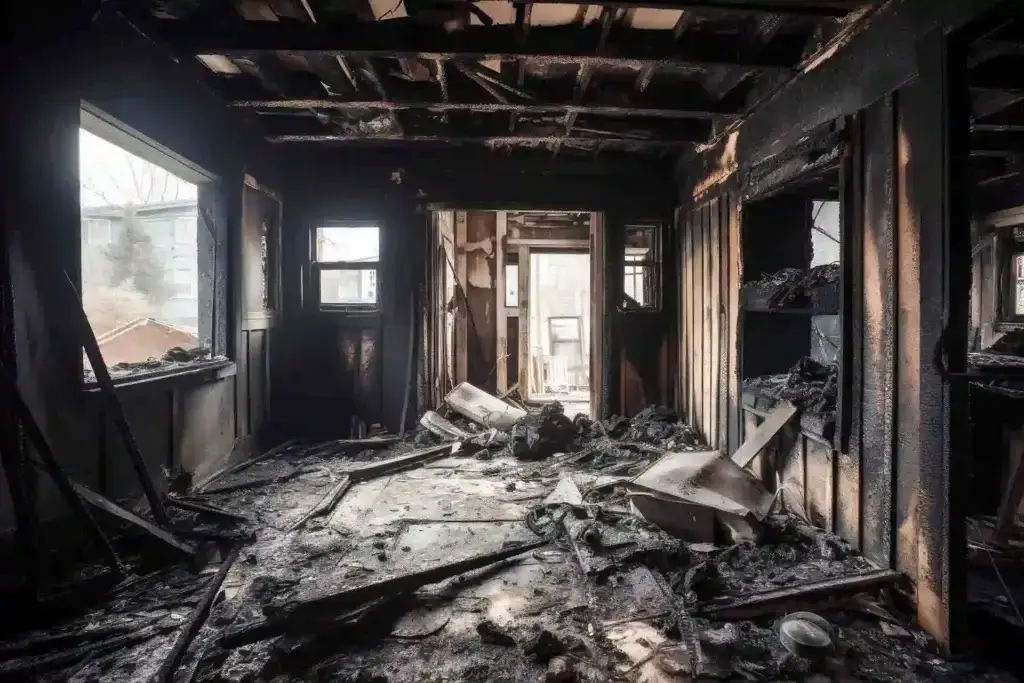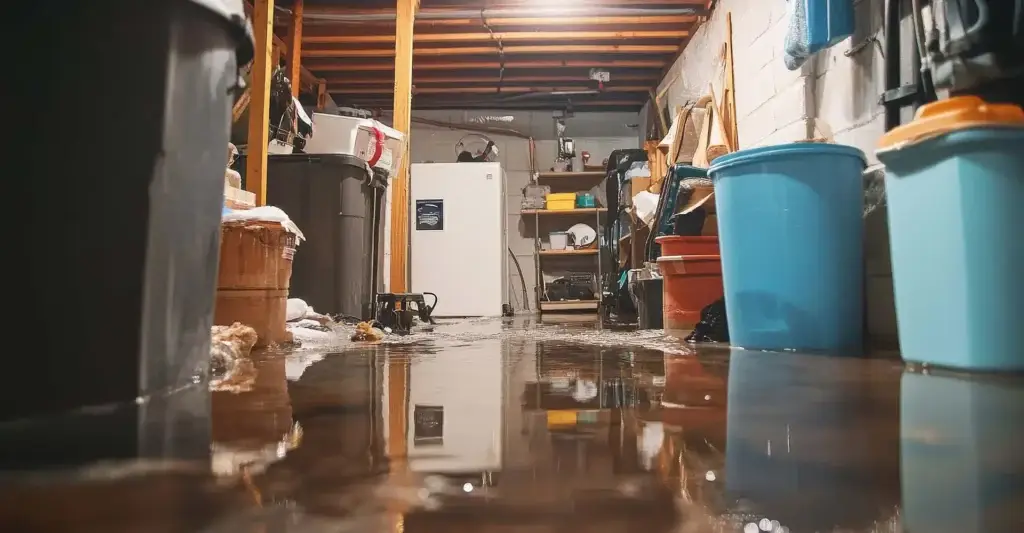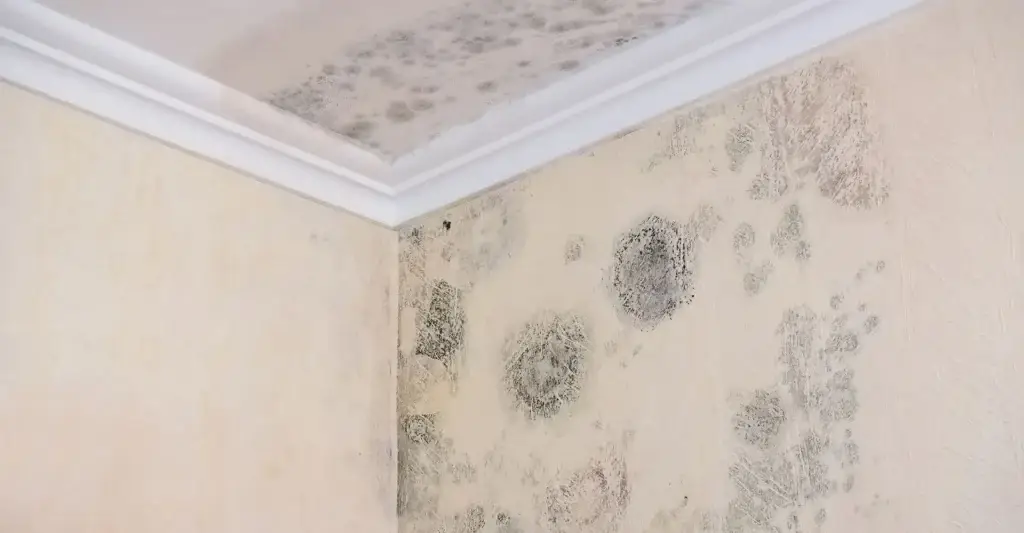Fire damage restoration is a comprehensive process designed to return a property to its pre-fire condition following damage from flames, smoke, soot, and often water used in firefighting. It goes beyond visible charring to address hidden issues like structural compromise, toxic smoke penetration, corrosive soot residue, water damage leading to mould, and persistent odours. The typical process for UK homes and businesses involves initial assessment and securing the building, followed by water extraction and drying. Next are specialised smoke and soot removal, thorough deep cleaning and sanitisation of contents, culminating in restoration and reconstruction to rebuild damaged areas. Engaging professional services is crucial for ensuring complete decontamination, safety, and a successful recovery.
To learn more about fire damage cleaning and restoration visit our services and see how it can benefit you.
Skip to:
Fire damage restoration in the UK
The fire damage restoration process
Fire damage restoration in UK homes
Fire damage restoration for UK businesses
Choosing the right service provider
Fire damage and restoration in the UK
Fire damage can wreak havoc on properties, whether residential or commercial, leaving not only physical destruction but also emotional and financial hardship in its wake. In the UK, fire and rescue services attended over 38,000 building fires in the year ending September 2024. This statistic alone highlights how common and devastating fire incidents are, making fire damage restoration a critical process for affected individuals and organisations.
In this guide, we’ll walk you through the stages of fire damage restoration, explain why professional help is often essential, and explore the key differences in approach between domestic and commercial fire incidents. This article also includes UK-specific data and best practices, aiming to provide an authoritative resource for anyone searching for fire damage restoration information.
Understanding fire damage
When most people think of fire damage, they picture charred walls and blackened furniture. However, the true extent of fire damage goes far beyond what’s immediately visible. Unfortunately, fires create several categories of destruction:
- Structural damage. Flames can compromise the integrity of walls, ceilings, floors, and support structures, making buildings unsafe to inhabit. This is often the most urgent concern immediately following a fire.
- Smoke and soot damage. Smoke contains toxic chemicals that can penetrate porous materials such as drywall, upholstery, and insulation. Soot, the black powdery residue left behind, clings to every surface and corrodes materials over time.
- Water damage. Ironically, extinguishing a fire often causes additional problems. Water from hoses or sprinkler systems can soak into flooring, walls, and furnishings, leading to issues like mould growth and structural weakening.
- Lingering odours are a persistent problem. Smoke odour can remain trapped in materials for weeks or even months if not treated properly with specialised deodorisation techniques.
The fire damage restoration process
Fire damage restoration is not a one-size-fits-all service. The process varies depending on the severity of the fire, the type of property, and the materials involved. However, the following six stages are typically included in a comprehensive restoration plan:
1. Emergency contact and initial assessment
The first step in fire damage restoration is rapid response. Restoration companies typically offer 24/7 emergency services because delays can worsen damage. Upon arrival, professionals assess the extent of fire, smoke, and water damage, often using moisture meters, thermal imaging, and visual inspections to form a detailed scope of work.
2. Securing the building
Once the assessment is complete, the next step involves securing the premises. This may include boarding up broken windows, tarping damaged roofs, and setting up temporary fencing to keep the site safe from weather damage, looters, or further accidents.
3. Water extraction and drying
Because fire-fighting efforts often involve large amounts of water, drying out the property is essential. Professionals use industrial-grade pumps, dehumidifiers, and air movers to remove moisture from walls, flooring, and furniture. Speed is critical at this stage to prevent mould and further structural damage.
4. Smoke and soot removal
This step involves cleaning all surfaces affected by smoke and soot, including ceilings, walls, flooring, and HVAC systems. Specialists use a variety of cleaning techniques depending on the material and extent of damage, such as dry sponging, soda blasting, and chemical cleaners.
5. Deep cleaning and sanitisation
Every item in the affected area needs to be cleaned and sanitised to remove odours, bacteria, and contaminants. This includes personal belongings, furniture, textiles, and more. Advanced deodorisation techniques like ozone treatments and thermal fogging are often employed.
6. Restoration and reconstruction
Finally, the focus shifts to repairing or rebuilding damaged areas. This could involve anything from replacing drywall and painting to reconstructing entire sections of a property. The goal is to return the building to its pre-fire condition, or better.
Fire damage restoration in UK homes
Domestic fires in the UK remain a significant issue. In 2024, house fires accounted for a large proportion of the 38,000 building fires recorded. Common causes include cooking accidents, faulty electrical systems, and unattended candles.
For homeowners, fire damage restoration involves more than just rebuilding. There is the emotional toll of losing personal possessions, family heirlooms, and the sense of security that one’s home provides. Professional restoration services help alleviate some of this burden by managing the process end-to-end, including insurance claims, which can average between £10,000 and £20,000 depending on the severity of the fire. Click the link to learn more about the cost of fire damage cleaning and restoration.
Moreover, many UK insurance providers require policyholders to work with certified restoration specialists. These professionals ensure that every aspect of the process meets industry standards and that homeowners receive the full value of their claim.
Read one of our domestic fire damage restoration case studies – Domestic Fire Caused by Lithium Batteries

Fire damage restoration for UK businesses
Commercial fires bring a different set of challenges. In the 2023/24 period, over 7,000 workplace fire incidents were reported. For businesses, a fire doesn’t just affect physical premises; it can interrupt operations, damage inventory, destroy essential data, and harm reputation.
One of the primary concerns for business owners is continuity. Time is money, and downtime due to fire damage can lead to lost revenue, layoffs, and even permanent closure. Restoration teams that specialise in commercial properties understand this urgency. They often work in stages or zones to allow parts of a business to resume operations as soon as it’s safe.
Another unique challenge in commercial settings is compliance. Businesses must adhere to a host of regulations including fire safety, electrical safety, and health standards. Post-fire, properties must pass inspections before reopening, and restoration companies play a key role in ensuring compliance.
In terms of scope, commercial restoration projects are often more complex and may involve coordination with multiple contractors, project managers, and insurers.
Read one of our commercial fire damage restoration case studies – Viridor’s Polymer Recycling Plant in Rochester.
Choosing the right fire damage restoration company
Choosing the right restoration company can mean the difference between a smooth recovery and months of ongoing problems.
First, look for certification and accreditation. In the UK, the British Damage Management Association (BDMA) certifies restoration professionals, ensuring they follow best practices and industry standards.
Experience is another critical factor. A company with a strong track record in handling fires similar to yours will be better equipped to anticipate challenges and deliver timely solutions.
Also consider the breadth of services offered. The best restoration companies provide comprehensive solutions, handling everything from initial assessment to getting the place ready for final restoration. This ensures continuity and reduces the risk of delays.
Finally, consult reviews and testimonials. Customer feedback can provide insight into a company’s reliability, quality of work, and communication practices.
Preventative measures to minimise fire risks
While restoration is critical after an incident, prevention is the best approach. Many fires are avoidable with proper precautions.
For homeowners, installing and regularly testing smoke alarms is essential. It’s also important to be vigilant in the kitchen, avoid overloading electrical sockets, and store flammable materials safely.
For businesses, regular fire risk assessments are legally required under the Regulatory Reform (Fire Safety) Order 2005. This includes checking emergency exits, testing alarm systems, and training staff on fire evacuation procedures.
Using fire retardant materials in construction and interior design can also mitigate the spread of flames and smoke, buying precious time for occupants to evacuate and for emergency services to respond.`
Conclusion: Essential fire damage restoration
Fire damage restoration is a vital service that helps individuals and organisations recover from one of the most traumatic types of property damage. The process involves much more than cleaning up, it’s about restoring safety, functionality, and peace of mind.
Whether you’re a homeowner dealing with the aftermath of a kitchen fire or a business owner facing significant operational disruption, working with a professional restoration company is key to a successful recovery. With a clear understanding of what fire damage restoration entails, and the right team by your side, it is possible to move forward with confidence and resilience.
If you’re searching for reliable fire damage restoration services in the UK, make sure the provider is experienced, certified, and capable of delivering tailored solutions that suit the specific situation at hand.
Don’t wait until disaster strike. Know your options, prepare a plan, and partner with experts who can help you protect what matters most.
If your property has suffered fire damage and you’re unsure where to turn, get in touch with our team. We offer fast, professional, and fully certified fire damage restoration services throughout the UK. Helping homeowners and businesses recover safely, efficiently, and with minimal disruption.
Need to speak to a specialist urgently? Call 01622 926 505
What does fire damage restoration entail: Frequently asked questions
What are the key stages of fire damage restoration for a property in the UK?
The key stages of fire damage restoration in the UK typically begin with emergency contact and initial assessment, followed by securing the building to prevent further issues. Crucially, water extraction and drying address firefighting efforts. Professionals then perform smoke and soot removal using specialised techniques, followed by deep cleaning and sanitisation of all affected contents. The final stage involves restoration and reconstruction to return the property to its pre-fire condition.
What types of damage does professional fire restoration address?
Professional fire damage restoration addresses multiple types of destruction, extending beyond visible charring. This includes structural damage (compromised walls, ceilings), smoke and soot damage (toxic chemicals, corrosive residue), water damage (from extinguishing efforts, preventing mould), and the elimination of persistent lingering odours embedded in materials.
Why is professional fire damage restoration essential after a fire?
Professional fire damage restoration is essential due to the complex and hazardous nature of post-fire environments. Experts possess the specialised equipment and techniques required for thorough decontamination, structural assessment, and effective removal of hidden smoke and soot. They also assist with insurance claims and ensure compliance with UK building and safety regulations, providing a safe and comprehensive recovery.
Does fire damage restoration include water damage clean-up from firefighting efforts?
Yes, fire damage restoration comprehensively includes water damage clean-up resulting from firefighting efforts. This critical stage involves using industrial-grade pumps, dehumidifiers, and air movers for rapid water extraction and thorough drying of walls, flooring, and furniture to prevent secondary issues such as mould growth and further structural weakening.
How do professionals remove smoke and soot damage from a property?
Professionals remove smoke and soot damage through a multi-faceted approach, cleaning all affected surfaces including ceilings, walls, flooring, and HVAC systems. Techniques include dry sponging, soda blasting, and chemical cleaners, depending on the material and severity. This process is followed by deep cleaning, sanitisation, and advanced deodorisation techniques like ozone treatments and thermal fogging to eliminate lingering odours and contaminants.
What is the difference in fire damage restoration for homes versus businesses in the UK?
While the core restoration process is similar, fire damage restoration for UK homes versus businesses differs primarily in focus and scale. For homes, the emphasis is often on the emotional toll and personal possessions, with professionals managing end-to-end insurance claims. For businesses, the priority is continuity and minimising operational downtime, often involving phased restoration, larger projects, and strict adherence to regulatory compliance before reopening.
What should I look for when choosing a fire damage restoration company in the UK?
When choosing a fire damage restoration company in the UK, prioritise firms with certification and accreditation (e.g., British Damage Management Association – BDMA) to ensure adherence to industry standards. Look for extensive experience in handling similar fire incidents, a breadth of comprehensive services from assessment to reconstruction, and positive customer reviews and testimonials that affirm their reliability and quality of work.

Kayleigh Owen - Technical Account Manager
With years of dedicated experience in the disaster recovery industry, Kayleigh Owen brings a precise and insightful approach to every project. Holding a BSc Hons Degree, Kayleigh specialises in construction and major loss, expertly navigating the complexities of large-scale fire and flood events. Having spent her entire industry career at Ideal Response, she has honed a deep understanding of what it takes to restore properties and lives with efficiency and empathy. Kayleigh believes that meticulous planning and clear communication are the cornerstones of transforming disaster into recovery, ensuring every client receives not just a solution, but true peace of mind.





















